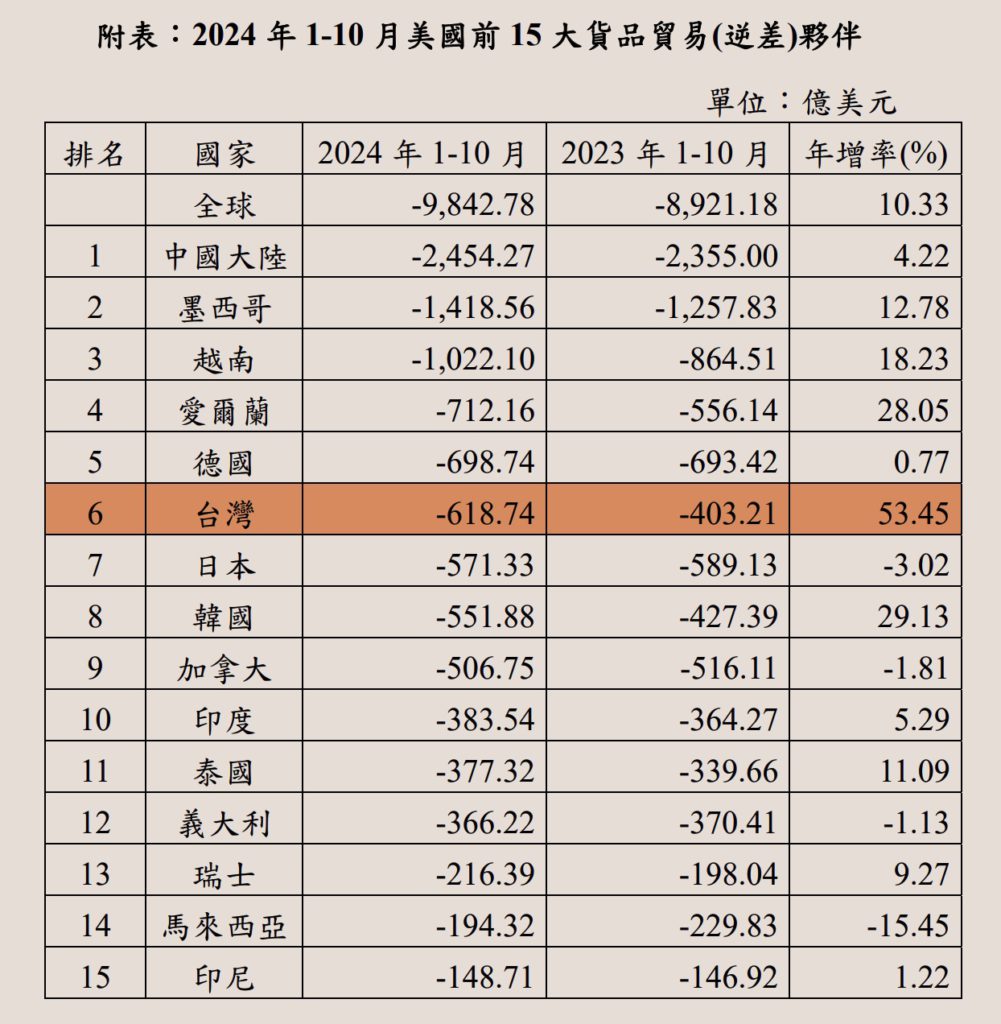US President Trump fired the first shot of his new term's tariff war last week, announcing that starting February 4, a 25% tariff will be imposed on Canada and Mexico, and an additional 10% tariff on China, triggering a global market turmoil.
As the reason for launching the tariff war, Trump has repeatedly stated that the US has long suffered greatly from the trade deficit, and now it is time to make America great again by reversing this situation:
The US has huge trade deficits with Canada, Mexico, China, and almost all countries, with a national debt of $36 trillion. We no longer want to be the suckers!
How Large is the US Trade Deficit?
According to the statistics, during the period from January to October 2024, the total US goods trade reached $4.4322 trillion, with exports of $1.724 trillion and imports of $2.7083 trillion, resulting in a trade deficit of $984.278 billion, an increase of 10.33% compared to the same period in 2023.
Specifically, the US trade deficits by country and region, from highest to lowest, are:
- Mainland China: $245.427 billion
- Mexico: $141.856 billion
- Vietnam: $102.21 billion
- Ireland: $71.216 billion
- Germany: $69.874 billion
- Taiwan: $61.874 billion
- Japan: $57.133 billion
- South Korea: $55.188 billion
- Canada: $50.675 billion
- India: $38.354 billion
- Thailand: $37.732 billion
- Italy: $36.622 billion
- Switzerland: $21.639 billion
- Malaysia: $19.432 billion
- Indonesia: $14.871 billion

In addition to goods trade, when including service trade and other factors, the overall US international trade deficit varies under different statistical calibers:
- According to data, the US international trade deficit was around $773.4 billion in 2023
- The US total trade deficit was around $948.1 billion in 2022
Is Trade Deficit Always Harmful to the Economy?
Trade deficit refers to a situation where the total value of a country's imports of goods and services exceeds the total value of its exports during a certain period, resulting in a deficit in the trade balance.
However, this does not mean only negative impacts. The US trade deficit also reflects the country's strong economic strength and ability to attract foreign investment, providing consumers with a wide range of relatively low-priced products and promoting the inflow of capital and technology.
On the other hand, long-term and persistent trade deficits may indeed have an impact on domestic industries and employment, increase the economy's dependence on external capital, and even trigger international trade frictions. How to balance short-term economic vitality and long-term industrial structure optimization is an important issue the US needs to weigh when facing trade deficits.
Advantages
- Diverse consumer choices and low prices
- Consumers benefit: A large number of imported goods allow consumers to purchase a wide variety of products at lower prices, thereby improving their quality of life and consumer welfare.
- Cost control: Low-cost imported raw materials and products help reduce production costs and promote the competitiveness of enterprises.
- Capital attraction and economic vitality
- Inflow of foreign capital: The United States has the world's major reserve currency - the US dollar, which makes it easier to attract foreign investment. Persistent trade deficits are often accompanied by a large influx of capital, which helps provide financial support for economic growth.
- Promoting investment: The inflow of foreign capital can be used to invest in infrastructure, technology R&D, and other productive areas, thereby driving the long-term development of the economy.
- Importing technology and resources
Disadvantages
- Impact on domestic industries
- Competitive pressure on manufacturing: A large number of low-cost imports may squeeze the market share of domestic manufacturing, leading to the shrinkage of some industries, and thus affecting employment and industrial structure.
- Employment issues: The decline of manufacturing and related industries may lead to a rise in the unemployment rate, especially for those regions and worker groups that rely on traditional industries.
- Accumulation of foreign debt and economic vulnerability
- Long-term debt risk: Persistent trade deficits mean that the United States needs to borrow foreign capital to balance its international payments. Long-term reliance on foreign debt may increase financial risks and form a dependence on foreign capital inflows.
- Risk of external shocks: If the external environment changes, such as foreign investors suddenly withdrawing their investments, it may have a greater impact on the US economy.
- International trade and political pressure
Trump: Postpone the imposition of tariffs on Mexico and Canada for 30 days
But just before the tariffs were officially implemented, Trump and Mexican President Claudia Sheinbaum held a conversation last night, and the two announced at midnight today (4th) that the 25% tariffs on Mexico would be postponed for one month. As a negotiation condition, Mexico has agreed to deploy 10,000 soldiers to the US-Mexico border to prevent illegal immigration and fentanyl from entering the United States.
A few hours later, Canadian Prime Minister Trudeau also stated that he had reached an agreement with Trump, and the US action to impose tariffs on Canada would also be postponed for 30 days. Trudeau posted on X that Canada will deploy nearly 10,000 frontline personnel to help secure the border, designate drug trafficking groups as terrorists, and appoint an official to oversee fentanyl.
From this, it seems that Trump's purpose in implementing the tariff policy is more inclined to use it as a bargaining chip, intending to obtain favorable conditions for the United States through tariff threats to Canada, Mexico, and China, and so far Trump's plan seems to be progressing smoothly.
Additionally, according to a report by The Wall Street Journal citing informed sources, Chinese authorities are also planning to take a softer stance, and their initial response measures to Trump's tariff war include: suggesting that China and the US resume the Phase One trade agreement, and planning to promise not to devalue the renminbi and increase investment in the US.







